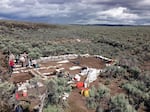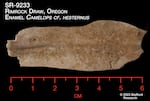Archaeologists have new evidence suggesting that humans occupied Oregon more than 18,000 years ago. This makes it one of the oldest known sites of human occupation in North America.
A 2023 radiocarbon dating analysis was made based on findings at the Rimrock Draw Rockshelter near Burns, Oregon. The University of Oregon Archaeological Field School has been excavating at the site, which features a shallow overhang in an otherwise open environment. The field school has been working in partnership with the Bureau of Land Management since 2011.

An archeological site at Rimrock Draw Rockshelter outside of Riley, Ore. The University of Oregon archeological field school discovered evidence suggesting animal and human habitation dating back more than 18,000 years.
Courtesy of Becky Raines / University of Oregon
UO staff archaeologist Patrick O’Grady said in 2012 the team found telling objects — camel tooth enamel fragments and a human-made tool — deep in the rock shelter, buried underneath the ash of a Mt. St. Helens eruption from over 15,000 years ago.
“So we’ve got volcanic ash, we’ve got the camelops tooth enamel, and then underneath those we have a beautiful orange stone tool made out of a fine-grained agate,” O’Grady said, “that was unmistakable as having been crafted by humans.”
Radiocarbon dating on the camel tooth enamel, first in 2018 and most recently in 2023, dated it as 18,250 years old.
“We ran one date, and we went, ‘Oh, my goodness, that’s pretty old,’” O’Grady said. “So we ran a second date on the same piece of tooth enamel, and ultimately, the date that we received in February of this year was pretty much spot on.”
This, along with the presence of the tool underneath the tooth fragments, suggests that the rockshelter may be one of the oldest human-occupied locations on the continent. Other ancient sites include Cooper’s Ferry in western Idaho, which dates back more than 16,000 years.
The field school is doing more work at Rimrock Draw Rockshelter this summer.

Camel tooth enamel discovered at the site of the Rimrock Draw Rockshelter. Radiocarbon dating from the University of Oregon suggests it dates back over 18,000 years ago.
Courtesy of the University of Oregon